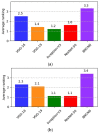A Deep Batch Normalized Convolution Approach for Improving COVID-19 Detection from Chest X-ray Images
- PMID: 36678365
- PMCID: PMC9860560
- DOI: 10.3390/pathogens12010017
A Deep Batch Normalized Convolution Approach for Improving COVID-19 Detection from Chest X-ray Images
Abstract
Pre-trained machine learning models have recently been widely used to detect COVID-19 automatically from X-ray images. Although these models can selectively retrain their layers for the desired task, the output remains biased due to the massive number of pre-trained weights and parameters. This paper proposes a novel batch normalized convolutional neural network (BNCNN) model to identify COVID-19 cases from chest X-ray images in binary and multi-class frameworks with a dual aim to extract salient features that improve model performance over pre-trained image analysis networks while reducing computational complexity. The BNCNN model has three phases: Data pre-processing to normalize and resize X-ray images, Feature extraction to generate feature maps, and Classification to predict labels based on the feature maps. Feature extraction uses four repetitions of a block comprising a convolution layer to learn suitable kernel weights for the features map, a batch normalization layer to solve the internal covariance shift of feature maps, and a max-pooling layer to find the highest-level patterns by increasing the convolution span. The classifier section uses two repetitions of a block comprising a dense layer to learn complex feature maps, a batch normalization layer to standardize internal feature maps, and a dropout layer to avoid overfitting while aiding the model generalization. Comparative analysis shows that when applied to an open-access dataset, the proposed BNCNN model performs better than four other comparative pre-trained models for three-way and two-way class datasets. Moreover, the BNCNN requires fewer parameters than the pre-trained models, suggesting better deployment suitability on low-resource devices.
Keywords: COVID-19; batch normalized convolutional neural network (BNCNN); chest X-ray; classification; deep learning.
Conflict of interest statement
The authors declare no conflict of interest.
Figures






References
-
- World Health Organization (WHO) Health Topics. [(accessed on 25 October 2021)]. Available online: www.who.int/bulletin/volumes/98/7/20-254045/en/
-
- Hall L.O., Paul R., Goldgof D.B., Goldgof G.M. Finding COVID-19 from chest x-rays using deep learning on a small dataset. arXiv. 20202004.02060
-
- Ardabili S.F., Mosavi A., Ghamisi P., Ferdinand F., Varkonyi-Koczy A.R., Reuter U., Atkinson P.M. COVID-19 outbreak prediction with machine learning. Algorithms. 2020;13:249. doi: 10.3390/a13100249. - DOI
LinkOut - more resources
Full Text Sources

